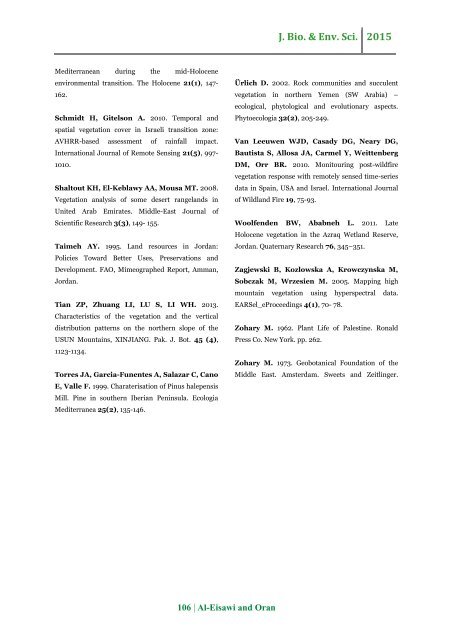Assessment of the vegetation cover of northern high mountains in Jordan - JBES
The vegetation cover of the northern mountains of Jordan was investigated and surveyed. Line transects sampling method as well as walking through methods have been applied in this study. A total area of 15x80 km was studied and divided into grid system, and thus the selected grids have been used for the line transect sampling. The study showed that the natural forest of Aleppo pine, evergreen oak forest, deciduous oak forest, degraded forest and manmade Aleppo pine forest areas are suffering from man interference and continuous encroachment for the uses of agriculture, urbanization, grazing, fire and querying. The available plant species under forest were collected and herbarium specimens are prepared and deposited. Analysis parameters such as density (D), relative density (RD), frequency (F), relative frequency (RF), abundance (A), relative abundance (RA) and the importance value (IV) are studied. The values of the parameters are recorded for all species, but since the number of collected species is more than 500, then these parameters are listed for the highest 20 species to show clear image about the most dominant and the most abundant and other parameters. From the quantitative ecological analysis using various parameters, the species recoded as having the highest values such as Quercus coccifera, Sarcopoterium spinosum, Asphodelus aestivus, Eryngium creticum, Ononis natrix and others confirm that the study area falls within a Mediterranean biogeographic zone in Jordan. Based on the obtained results, it is highly recommended thus to exert maximum efforts to conserve such limited forest cover, since Jordan, is classified as a country with dry to semidry ecosystem. In addition some of the rare and endemic recorded species occur only under forest cover, particularly the orchid species. This articles originally published at: http://www.innspub.net/volume-6-number-5-may-2015-jbes/
The vegetation cover of the northern mountains of Jordan was investigated and surveyed. Line transects sampling method as well as walking through methods have been applied in this study. A total area of 15x80 km was studied and divided into grid system, and thus the selected grids have been used for the line transect sampling. The study showed that the natural forest of Aleppo pine, evergreen oak forest, deciduous oak forest, degraded forest and manmade Aleppo pine forest areas are suffering from man interference and continuous encroachment for the uses of agriculture, urbanization, grazing, fire and querying. The available plant species under forest were collected and herbarium specimens are prepared and deposited. Analysis parameters such as density (D), relative density (RD), frequency (F), relative frequency (RF), abundance (A), relative abundance (RA) and the importance value (IV) are studied. The values of the parameters are recorded for all species, but since the number of collected species is more than 500, then these parameters are listed for the highest 20 species to show clear image about the most dominant and the most abundant and other parameters. From the quantitative ecological analysis using various parameters, the species recoded as having the highest values such as Quercus coccifera, Sarcopoterium spinosum, Asphodelus aestivus, Eryngium creticum, Ononis natrix and others confirm that the study area falls within a Mediterranean biogeographic zone in Jordan. Based on the obtained results, it is highly recommended thus to exert maximum efforts to conserve such limited forest cover, since Jordan, is classified as a country with dry to semidry ecosystem. In addition some of the rare and endemic recorded species occur only under forest cover, particularly the orchid species. This articles originally published at: http://www.innspub.net/volume-6-number-5-may-2015-jbes/
You also want an ePaper? Increase the reach of your titles
YUMPU automatically turns print PDFs into web optimized ePapers that Google loves.
J. Bio. & Env. Sci. 2015<br />
Mediterranean dur<strong>in</strong>g <strong>the</strong> mid-Holocene<br />
environmental transition. The Holocene 21(1), 147-<br />
162.<br />
Schmidt H, Gitelson A. 2010. Temporal and<br />
spatial <strong>vegetation</strong> <strong>cover</strong> <strong>in</strong> Israeli transition zone:<br />
AVHRR-based assessment <strong>of</strong> ra<strong>in</strong>fall impact.<br />
International Journal <strong>of</strong> Remote Sens<strong>in</strong>g 21(5), 997-<br />
1010.<br />
Shaltout KH, El-Keblawy AA, Mousa MT. 2008.<br />
Vegetation analysis <strong>of</strong> some desert rangelands <strong>in</strong><br />
United Arab Emirates. Middle-East Journal <strong>of</strong><br />
Scientific Research 3(3), 149- 155.<br />
Taimeh AY. 1995. Land resources <strong>in</strong> <strong>Jordan</strong>:<br />
Policies Toward Better Uses, Preservations and<br />
Development. FAO, Mimeographed Report, Amman,<br />
<strong>Jordan</strong>.<br />
Tian ZP, Zhuang LI, LU S, LI WH. 2013.<br />
Characteristics <strong>of</strong> <strong>the</strong> <strong>vegetation</strong> and <strong>the</strong> vertical<br />
distribution patterns on <strong>the</strong> nor<strong>the</strong>rn slope <strong>of</strong> <strong>the</strong><br />
USUN Mounta<strong>in</strong>s, XINJIANG. Pak. J. Bot. 45 (4),<br />
1123-1134.<br />
Torres JA, Garcia-Funentes A, Salazar C, Cano<br />
E, Valle F. 1999. Charaterisation <strong>of</strong> P<strong>in</strong>us halepensis<br />
Mill. P<strong>in</strong>e <strong>in</strong> sou<strong>the</strong>rn Iberian Pen<strong>in</strong>sula. Ecologia<br />
Mediterranea 25(2), 135-146.<br />
Ürlich D. 2002. Rock communities and succulent<br />
<strong>vegetation</strong> <strong>in</strong> nor<strong>the</strong>rn Yemen (SW Arabia) –<br />
ecological, phytological and evolutionary aspects.<br />
Phytoecologia 32(2), 205-249.<br />
Van Leeuwen WJD, Casady DG, Neary DG,<br />
Bautista S, Allosa JA, Carmel Y, Weittenberg<br />
DM, Orr BR. 2010. Monitour<strong>in</strong>g post-wildfire<br />
<strong>vegetation</strong> response with remotely sensed time-series<br />
data <strong>in</strong> Spa<strong>in</strong>, USA and Israel. International Journal<br />
<strong>of</strong> Wildland Fire 19, 75-93.<br />
Woolfenden BW, Ababneh L. 2011. Late<br />
Holocene <strong>vegetation</strong> <strong>in</strong> <strong>the</strong> Azraq Wetland Reserve,<br />
<strong>Jordan</strong>. Quaternary Research 76, 345–351.<br />
Zagjewski B, Kozlowska A, Krowczynska M,<br />
Sobczak M, Wrzesien M. 2005. Mapp<strong>in</strong>g <strong>high</strong><br />
mounta<strong>in</strong> <strong>vegetation</strong> us<strong>in</strong>g hyperspectral data.<br />
EARSel_eProceed<strong>in</strong>gs 4(1), 70- 78.<br />
Zohary M. 1962. Plant Life <strong>of</strong> Palest<strong>in</strong>e. Ronald<br />
Press Co. New York. pp. 262.<br />
Zohary M. 1973. Geobotanical Foundation <strong>of</strong> <strong>the</strong><br />
Middle East. Amsterdam. Sweets and Zeitl<strong>in</strong>ger.<br />
106 | Al-Eisawi and Oran


















